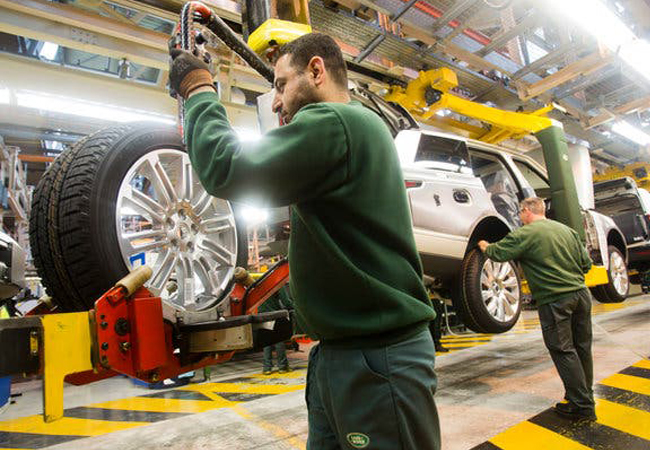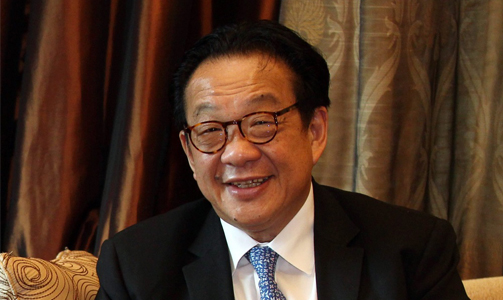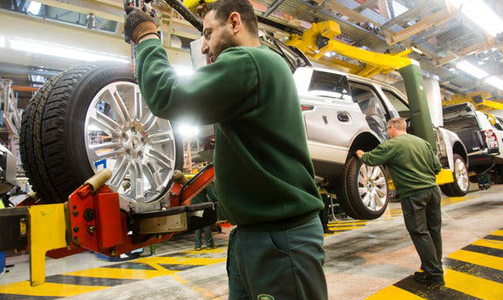In Jaguar, Emblem of a Broader Revival in Britain

New York Times, May 28, 2013
By STANLEY REED
SOLIHULL, England — It was a crucial day for Demos Hoursoglou. The manager of the aluminum body shop at Jaguar Land Rover’s manufacturing complex in this suburb of Birmingham, England, was about to give the go-ahead to plug a brand new model — the Range Rover Sport — into the assembly line. It would be the latest type of top-of-the-line Range Rover to receive an aluminum body since this factory went into operation last September.
Striding on a catwalk above the shop floor, Mr. Hoursoglou pointed out the cutting-edge elements of his highly automated shop, which represents a big chunk of the company’s recent investment of £370 million, or about $560 million, at the 300-acre, or 120-hectare, site. The line, on which robots do most of the routine work, is unusual in the automotive world in being able to switch from model to model, and to different specifications like right-hand or left-hand drive, without missing a beat or causing any increases in operating cost.
“This company invests,” Mr. Hoursoglou said, explaining why he joined Jaguar Land Rover from Honda last year. Tata Motors “saw something in JLR that no one else did,” he said. “The results justify the decision.”
It was Tata Motors, part of the giant Indian conglomerate Tata Group, that saved the iconic Jaguar and Land Rover brands from an uncertain future by buying them from Ford Motor for $2.3 billion in 2008. On Wednesday, when Tata Motors is set to announce its results for the financial year that ended in March, investors will be watching to see if the rejuvenated Jaguar Land Rover unit continues to prop up its parent, whose core Indian business has recently sustained declining earnings and revenue.
Since the depths of the financial crisis in 2009, Jaguar Land Rover’s output under Tata has nearly doubled, to about 357,000 vehicles last year. It is just one of several car companies, including Nissan and General Motors, whose output is growing in Britain, even as vehicle production is declining in European countries like Spain, France, and Italy and auto sales on the Continent have fallen to levels not seen since the mid-1990s.
The recipe for this British revival has been largely the same from company to company: foreign ownership, which brings new ideas and much-needed capital. And along with much of Britain’s other automotive output, more than 80 percent of Jaguar Land Rover’s vehicles are exported, with the United States and China the leading destinations.
Since emerging from the financial crisis, Jaguar Land Rover has been pouring money — £2 billion to £3 billion a year — into new models, new plants and new technology with the encouragement of Tata Group’s former chairman, Ratan Tata, and his successor, Cyrus P. Mistry, who is also chairman of the Jaguar Land Rover board.
“For many years these brands were labeled as having a lot of potential; but for many years they failed to live up to that,” said Peter Wells, co-director of the Center for Automotive Industry Research at Cardiff University. “These brands really required significant investment to bring the product ranges and manufacturing up to speed,” he said. “Under Tata we have seen that kind of investment.”
It helps, of course, that Tata Motors has deep pockets, by virtue not only of its strong position in the Indian car market, but by dint of being owned by Tata Group, whose holdings include power, steel, beverages and hotels. The group generated about $100 billion in revenue last year.
And Britain, for its part, has been willing to streamline its auto industry in ways that other West European countries continue to resist, through steps like closing plants and cutting workers. “We went through processes here a few years earlier than anywhere else,” Mr. Wells said, noting the collapse of the British carmaker MG Rover in 2005. “France, Spain, and Italy have not been through that yet.”
Companies like Tata that are willing to build on the rubble of the British industry gain access to Britain’s design and engineering talents. Jaguar Land Rover is spreading investment across its operations, which are mostly in the central part of England, known as the Midlands.
About two years ago it brought out a mid-price sport utility vehicle called the Range Rover Evoque, the company’s first model to top the sales threshold of 100,000 vehicles a year. To replace the Ford engines it currently puts under its hoods, Jaguar Land Rover is spending £500 million on a new engine plant in Wolverhampton that is scheduled to start operating in 2015.
Meanwhile, drawing on its heritage of classic cars like the Jaguar XKE, the company is rolling out a two-seater sports car — the F-type — for the first time in almost 40 years.
At the time of the Tata takeover, Jaguar Land Rover employed about 14,500. Since then it has hired about 9,000 people, half of them engineers and designers, and most of them in Britain. Of the company’s overall work force now, only about 1,000 or so work outside the United Kingdom.
Working for the Tatas, with their long-term view, is “very different” from working at a Western auto company, said Mike Wright, a longtime Jaguar Land Rover executive, who is currently executive director. “In the Western world there is a lot more focus on quarterly results.”
At Solihull, construction workers are putting up the shell of a big new building at the site, which was home to a former World War II aircraft and tank engine plant where the first Land Rover was made from surplus aluminum in 1948. Executives are cagey about the new building’s purpose, but analysts guess that it might be intended for aluminum bodies for other models now built on conventional steel frames, like the Discovery.
Ralf Speth, a former BMW executive who became Jaguar Land Rover’s chief in 2010, argues that a shift to aluminum, which can reduce a vehicle’s weight about 40 percent, is necessary for raising fuel efficiency and cutting carbon dioxide emissions, while matching or beating competitors like Mercedes and BMW, which are making growing use of aluminum and some carbon-fiber parts to cut weight and improve fuel efficiency.
Jaguar Land Rover is betting that even as its customers want to be able to feel they are doing their part to reduce carbon emissions, they still want the acceleration that an internal combustion engine can deliver.
“At the moment I’m not a big fan of electric,” Mr. Speth said in an interview at the Paris Motor Show last year. “We will be focusing on internal combustion,” he said. But he noted that the company was also working on “alternative systems,” like the hybrid-diesel Range Rover due this year.
So far, the investments are paying off. Tata got a nasty surprise in its first year as Jaguar Land Rover’s owner when the financial crisis played a role in a sales collapse, particularly for Land Rovers. Tata’s new unit posted a loss of £375 million for the 2008-9 financial year.
Since then, the company’s performance has improved sharply. Profit after taxes reached £837 million on sales of £10.7 billion for the nine months ending in December 2012.
Jaguar Land Rover’s sales and profits, though, still lag far behind those of its main European rivals. BMW had a net profit of €5.1 billion, or $6.4 billion, last year and sold 1.85 million cars, while Daimler’s Mercedes-Benz unit reported a pretax profit of €4.4 billion on sales of 1.45 million passenger cars.
The question is whether Jaguar Land Rover can build further on its turnaround. One of the company’s next big moves will be making cars in China, where it plans to invest £500 million in a plant, and starting production in India, where it is already assembling Jaguars and S.U.V.’s from kits. While those are big potential markets, there is a risk of muddying the company’s made-in-Britain image.
And Jaguar Land Rover also is up against deep-pocketed competitors, especially the German carmakers, who have their own S.U.V. entries as well as formidable sedans to challenge Jaguar’s. That means it will have to spend big money to compete. But analysts say the pressure is helping to motivate the company.
Jaguar Land Rover “is pretty well at the cutting edge of technology in every area,” said Lord Kumar Bhattacharyya, whose Warwick Manufacturing Group, an industrial research unit at the University of Warwick, works closely with the company. “That is the only way they can survive in a niche market where they are competing with BMW and Mercedes.”
At the body shop, Mr. Hoursoglou is well aware of the need to gain an edge wherever the company can. His aluminum cars, he claims, grinning, are “kilograms lighter” than the S.U.V.’s made by his German rivals.
Jack Ewing contributed reporting from Frankfurt.
Back



